2019 TOYOTA YARIS HATCHBACK trailer
[x] Cancel search: trailerPage 3 of 692
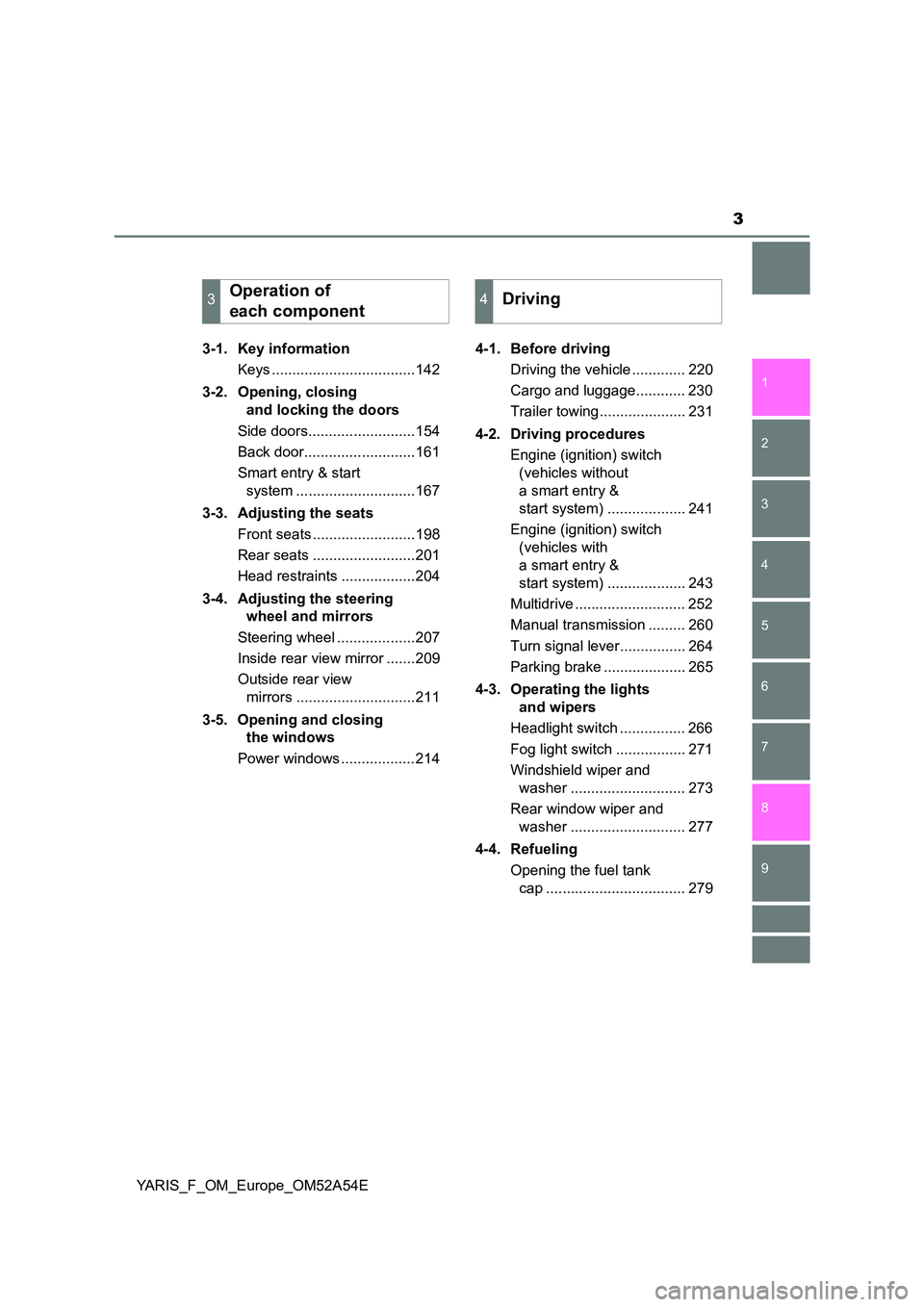
3
1
7
8
6
5
4
3
2
9
YARIS_F_OM_Europe_OM52A54E
3-1. Key information
Keys ...................................142
3-2. Opening, closing
and locking the doors
Side doors..........................154
Back door...........................161
Smart entry & start
system .............................167
3-3. Adjusting the seats
Front seats .........................198
Rear seats .........................201
Head restraints ..................204
3-4. Adjusting the steering
wheel and mirrors
Steering wheel ...................207
Inside rear view mirror .......209
Outside rear view
mirrors .............................211
3-5. Opening and closing
the windows
Power windows ..................214
4-1. Before driving
Driving the vehicle ............. 220
Cargo and luggage............ 230
Trailer towing..................... 231
4-2. Driving procedures
Engine (ignition) switch
(vehicles without
a smart entry &
start system) ................... 241
Engine (ignition) switch
(vehicles with
a smart entry &
start system) ................... 243
Multidrive ........................... 252
Manual transmission ......... 260
Turn signal lever................ 264
Parking brake .................... 265
4-3. Operating the lights
and wipers
Headlight switch ................ 266
Fog light switch ................. 271
Windshield wiper and
washer ............................ 273
Rear window wiper and
washer ............................ 277
4-4. Refueling
Opening the fuel tank
cap .................................. 279
3Operation of
each component4Driving
Page 219 of 692

219
4Driving
YARIS_F_OM_Europe_OM52A54E4-1. Before driving
Driving the vehicle ............. 220
Cargo and luggage ............ 230
Trailer towing ..................... 231
4-2. Driving procedures
Engine (ignition) switch
(vehicles without
a smart entry &
start system) .................... 241
Engine (ignition) switch
(vehicles with
a smart entry &
start system) .................... 243
Multidrive ........................... 252
Manual transmission.......... 260
Turn signal lever ................ 264
Parking brake .................... 265
4-3. Operating the lights
and wipers
Headlight switch ................ 266
Fog light switch .................. 271
Windshield wiper and
washer ............................. 273
Rear window wiper and
washer ............................. 2774-4. Refueling
Opening the fuel tank
cap ................................... 279
4-5. Toyota Safety Sense
Toyota Safety Sense ......... 282
PCS
(Pre-Crash Safety
system) ............................ 290
LDA
(Lane Departure Alert) ..... 307
Automatic High Beam ........ 314
RSA (Road Sign Assist)..... 319
4-6. Using the driving support
systems
Cruise control..................... 325
Speed limiter ...................... 329
Rear view
monitor system ................ 334
Stop & start system............ 344
Driving assist systems ....... 355
4-7. Driving tips
Winter driving tips .............. 362
Page 223 of 692

2234-1. Before driving
4
Driving
YARIS_F_OM_Europe_OM52A54E
■When starting off on an uphill
The hill-start assist control will activate. (P. 358)
■Driving in the rain
●Drive carefully when it is raining, because visibility will be reduced, the win-
dows may become fogged-up, and the road will be slippery.
●Drive carefully when it starts to rain, because the road surface will be espe-
cially slippery.
●Refrain from high speeds when driving on an expressway in the rain,
because there may be a layer of water between the tires and the road sur-
face, preventing the steering and brakes from operating properly.
■Engine speed while driving (vehicles with a Multidrive)
In the following conditions, the engine speed may become high while driving.
This is due to automatic up-shifting control or down-shifting implementation to
meet driving conditions. It does not indicate sudden acceleration.
●The vehicle is judged to be driving uphill or downhill
●When the accelerator pedal is released
●When the brake pedal is depressed while sport mode is selected
■Breaking in your new Toyota
To extend the life of the vehicle, observing the following precautions is recom-
mended:
●For the first 300 km (200 miles):
Avoid sudden stops.
●For the first 800 km (500 miles):
Do not tow a trailer.
●For the first 1000 km (600 miles):
• Do not drive at extremely high speeds.
• Avoid sudden acceleration.
• Do not drive continuously in low gears.
• Do not drive at a constant speed for extended periods.
■Operating your vehicle in a foreign country
Comply with the relevant vehicle registration laws and confirm the availability
of the correct fuel. (P. 664)
Page 231 of 692
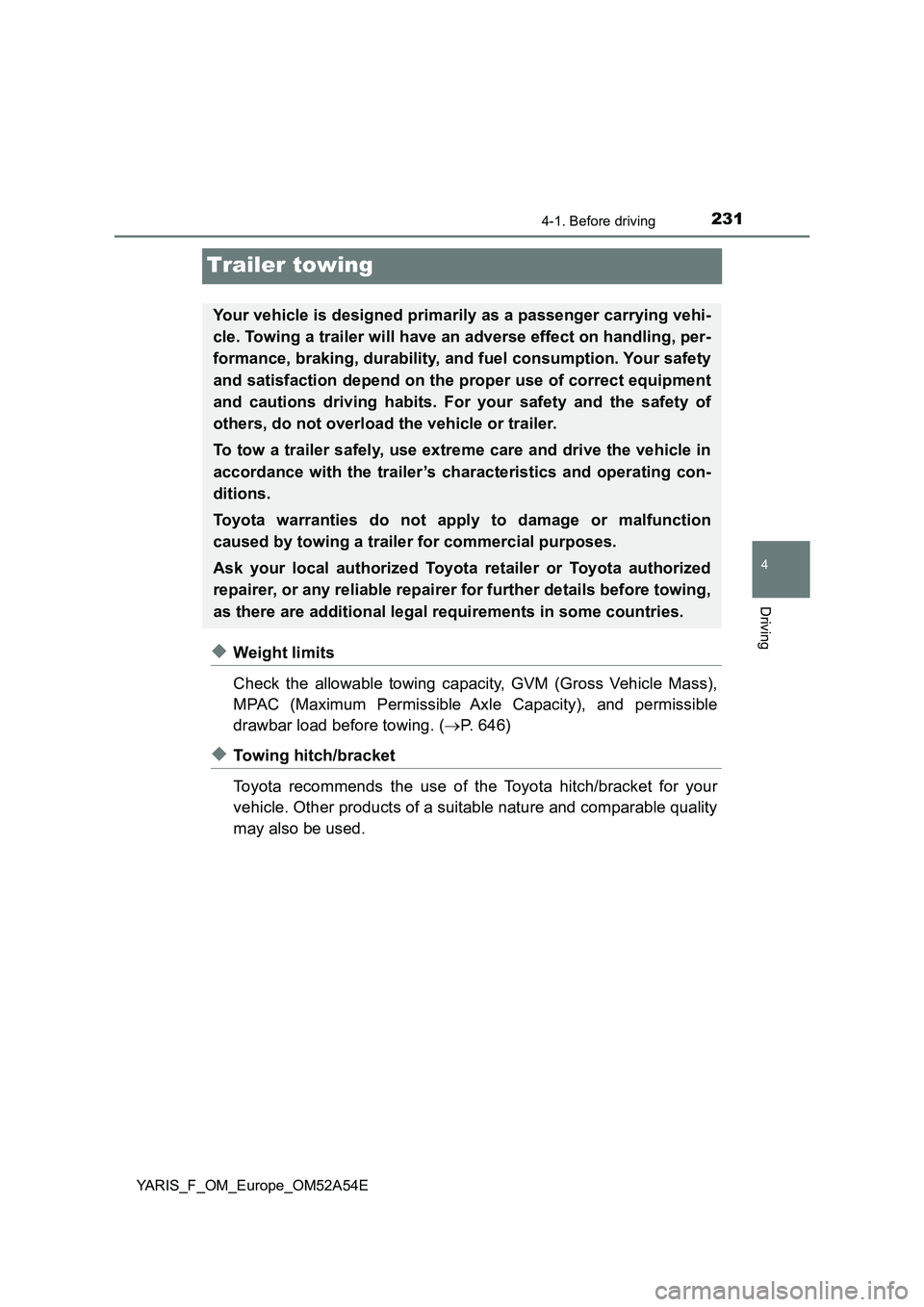
231
4
4-1. Before driving
Driving
YARIS_F_OM_Europe_OM52A54E
Trailer towing
◆Weight limits
Check the allowable towing capacity, GVM (Gross Vehicle Mass),
MPAC (Maximum Permissible Axle Capacity), and permissible
drawbar load before towing. (P. 646)
◆Towing hitch/bracket
Toyota recommends the use of the Toyota hitch/bracket for your
vehicle. Other products of a suitable nature and comparable quality
may also be used.
Your vehicle is designed primarily as a passenger carrying vehi-
cle. Towing a trailer will have an adverse effect on handling, per-
formance, braking, durability, and fuel consumption. Your safety
and satisfaction depend on the proper use of correct equipment
and cautions driving habits. For your safety and the safety of
others, do not overload the vehicle or trailer.
To tow a trailer safely, use extreme care and drive the vehicle in
accordance with the trailer’s characteristics and operating con-
ditions.
Toyota warranties do not apply to damage or malfunction
caused by towing a trailer for commercial purposes.
Ask your local authorized Toyota retailer or Toyota authorized
repairer, or any reliable repairer for further details before towing,
as there are additional legal requirements in some countries.
Page 232 of 692
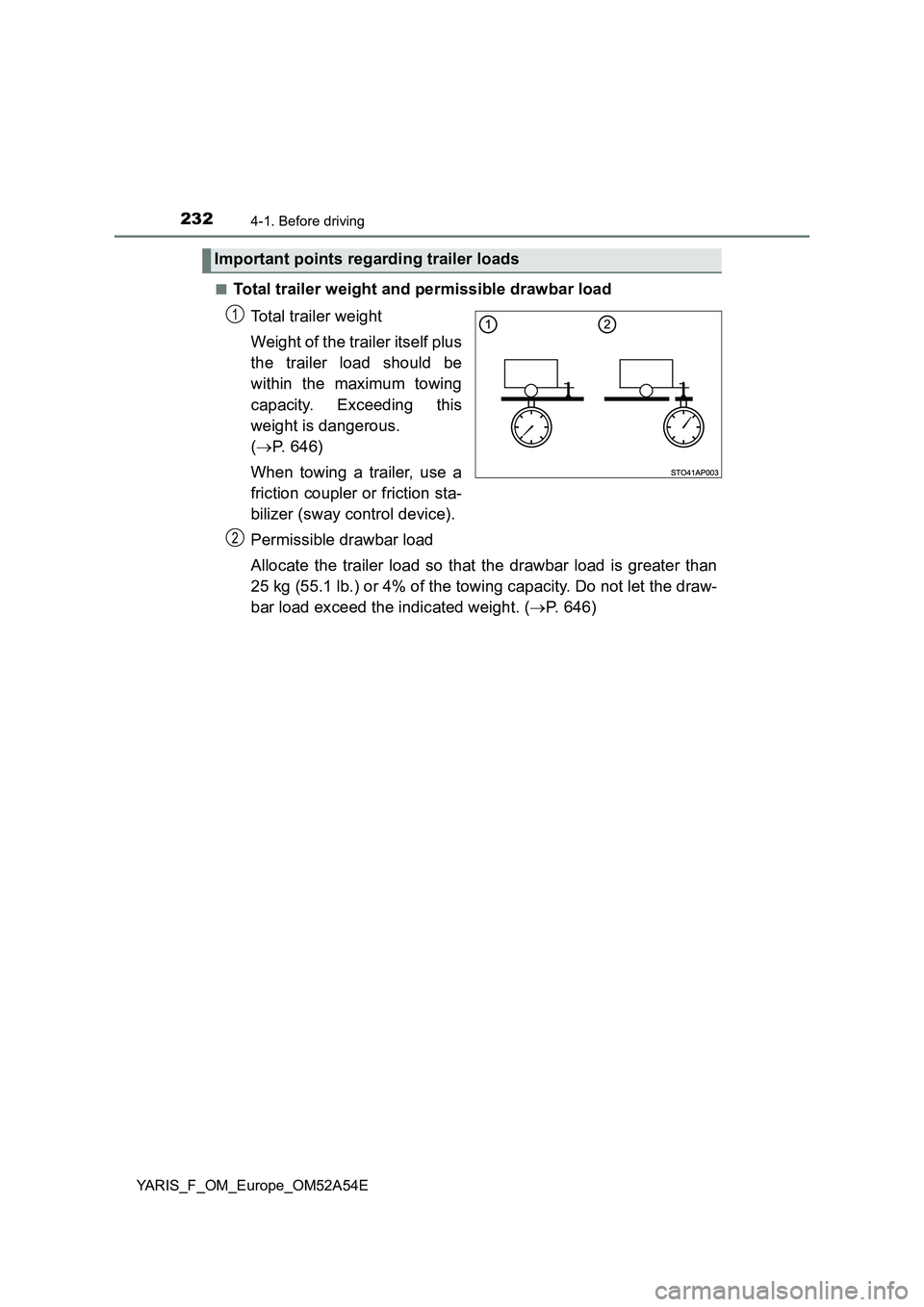
2324-1. Before driving
YARIS_F_OM_Europe_OM52A54E■
Total trailer weight and permissible drawbar load
Total trailer weight
Weight of the trailer itself plus
the trailer load should be
within the maximum towing
capacity. Exceeding this
weight is dangerous.
(P. 646)
When towing a trailer, use a
friction coupler or friction sta-
bilizer (sway control device).
Permissible drawbar load
Allocate the trailer load so that the drawbar load is greater than
25 kg (55.1 lb.) or 4% of the towing capacity. Do not let the draw-
bar load exceed the indicated weight. (P. 646)
Important points regarding trailer loads
1
2
Page 234 of 692
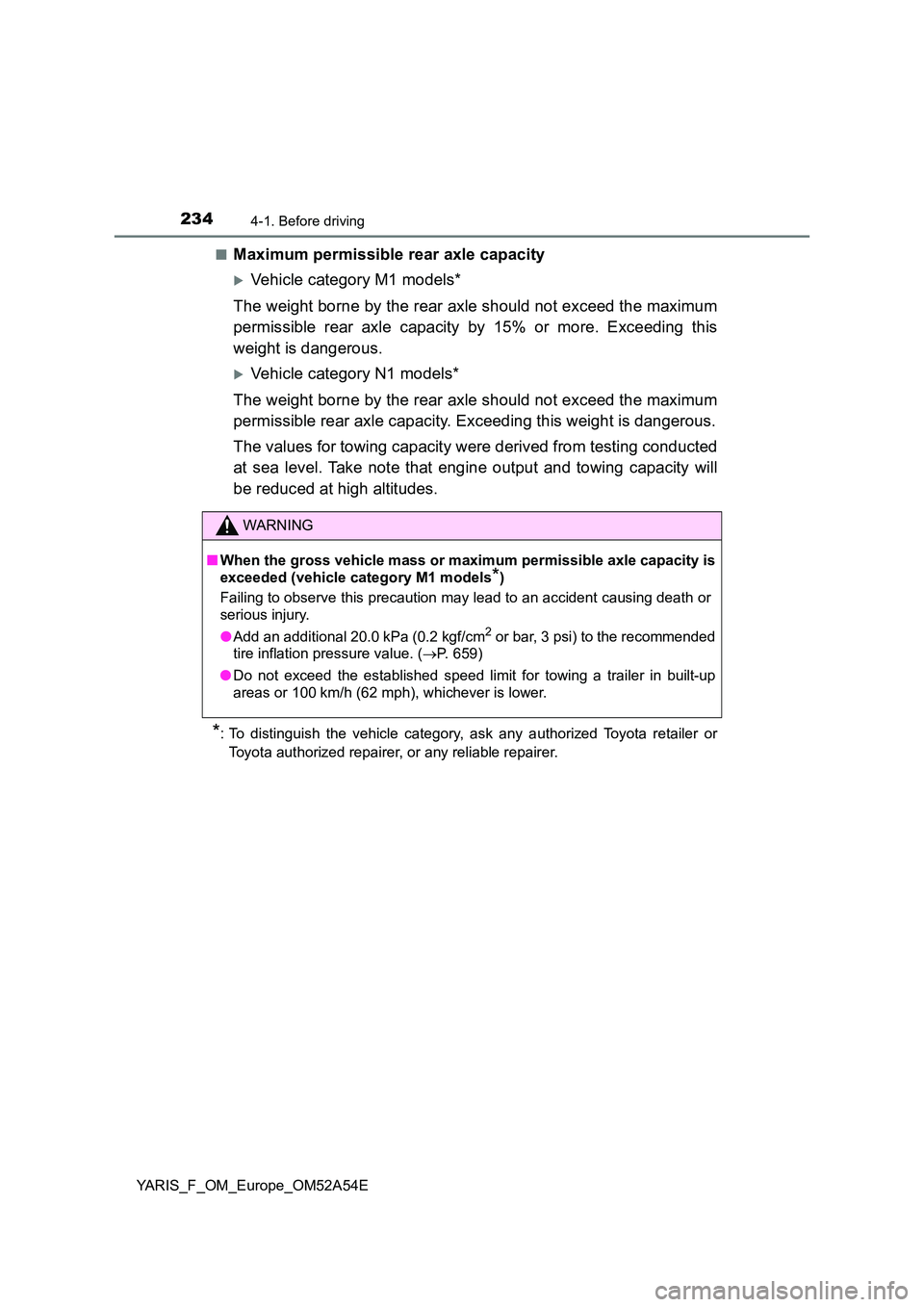
2344-1. Before driving
YARIS_F_OM_Europe_OM52A54E
■Maximum permissible rear axle capacity
Vehicle category M1 models*
The weight borne by the rear axle should not exceed the maximum
permissible rear axle capacity by 15% or more. Exceeding this
weight is dangerous.
Vehicle category N1 models*
The weight borne by the rear axle should not exceed the maximum
permissible rear axle capacity. Exceeding this weight is dangerous.
The values for towing capacity were derived from testing conducted
at sea level. Take note that engine output and towing capacity will
be reduced at high altitudes.
*: To distinguish the vehicle category, ask any authorized Toyota retailer or
Toyota authorized repairer, or any reliable repairer.
WARNING
■ When the gross vehicle mass or maximum permissible axle capacity is
exceeded (vehicle category M1 models*)
Failing to observe this precaution may lead to an accident causing death or
serious injury.
● Add an additional 20.0 kPa (0.2 kgf/cm2 or bar, 3 psi) to the recommended
tire inflation pressure value. ( P. 659)
● Do not exceed the established speed limit for towing a trailer in built-up
areas or 100 km/h (62 mph), whichever is lower.
Page 237 of 692
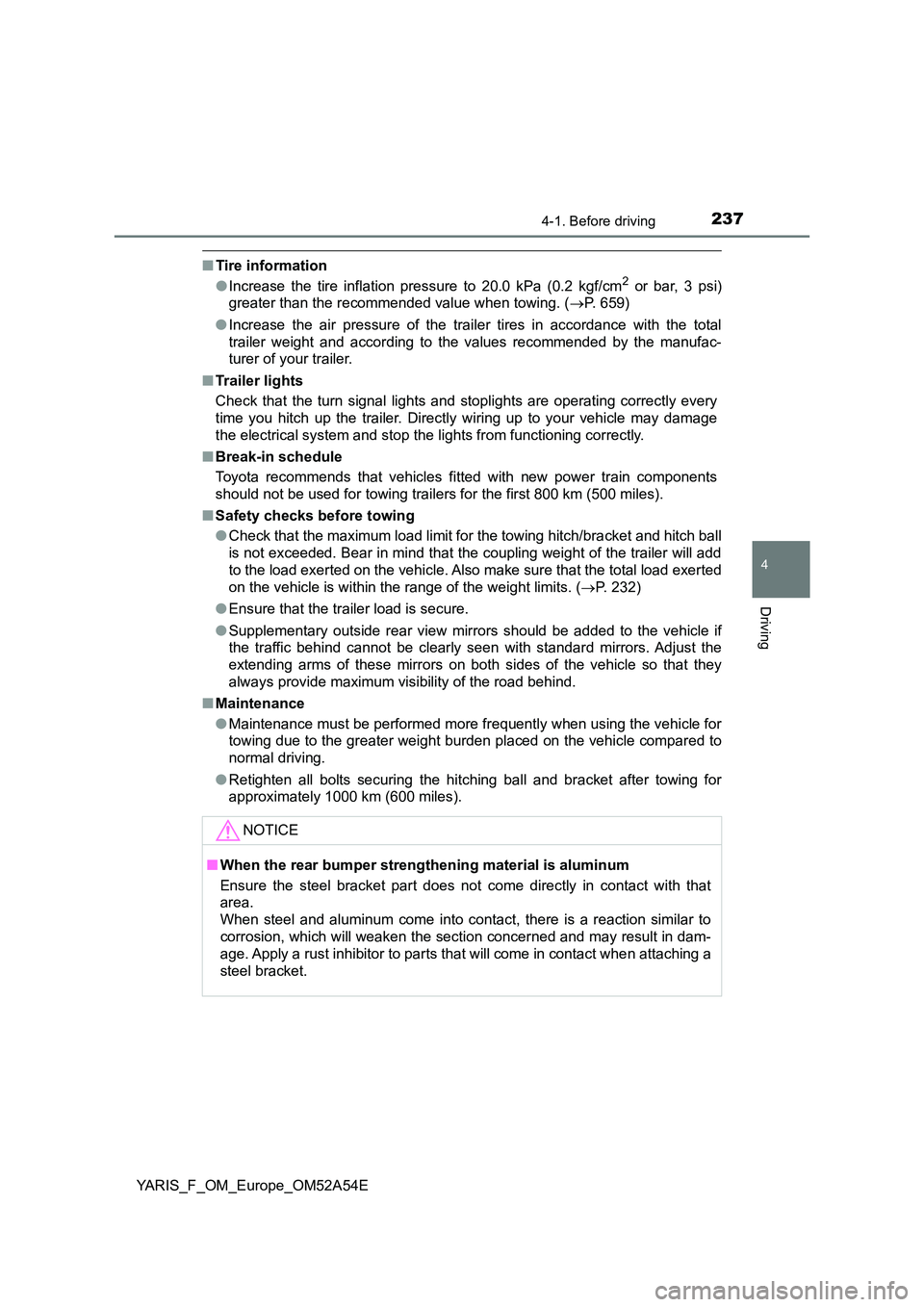
2374-1. Before driving
4
Driving
YARIS_F_OM_Europe_OM52A54E
■Tire information
● Increase the tire inflation pressure to 20.0 kPa (0.2 kgf/cm2 or bar, 3 psi)
greater than the recommended value when towing. ( P. 659)
● Increase the air pressure of the trailer tires in accordance with the total
trailer weight and according to the values recommended by the manufac-
turer of your trailer.
■ Tr a i l e r l i g h ts
Check that the turn signal lights and stoplights are operating correctly every
time you hitch up the trailer. Direct ly wiring up to your vehicle may damage
the electrical system and stop the lights from functioning correctly.
■ Break-in schedule
Toyota recommends that vehicles fitted with new power train components
should not be used for towing trailers for the first 800 km (500 miles).
■ Safety checks before towing
● Check that the maximum load limit for the towing hitch/bracket and hitch ball
is not exceeded. Bear in mind that the coupling weight of the trailer will add
to the load exerted on the vehicle. Also make sure that the total load exerted
on the vehicle is within the range of the weight limits. ( P. 232)
● Ensure that the trailer load is secure.
● Supplementary outside rear view mirrors should be added to the vehicle if
the traffic behind cannot be clearly seen with standard mirrors. Adjust the
extending arms of these mirrors on both sides of the vehicle so that they
always provide maximum visibility of the road behind.
■ Maintenance
● Maintenance must be performed more frequently when using the vehicle for
towing due to the greater weight burden placed on the vehicle compared to
normal driving.
● Retighten all bolts securing the hitching ball and bracket after towing for
approximately 1000 km (600 miles).
NOTICE
■ When the rear bumper strengthening material is aluminum
Ensure the steel bracket part does not come directly in contact with that
area.
When steel and aluminum come into contact, there is a reaction similar to
corrosion, which will weaken the section concerned and may result in dam-
age. Apply a rust inhibitor to parts that will come in contact when attaching a
steel bracket.
Page 238 of 692

2384-1. Before driving
YARIS_F_OM_Europe_OM52A54E
Your vehicle will handle differently when towing a trailer. In order to
avoid accident, death or serious injury, keep the following in mind
when towing:
■Checking connections between trailer and lights
Stop the vehicle and check the operation of the connection between
the trailer and lights after driving for a brief period as well as before
starting off.
■Practicing driving with a coupled trailer
●Get the feel for turning, stopping and reversing with the trailer
coupled by practicing in an area with no or light traffic.
●When reversing with a coupled trailer, hold the section of the
steering wheel nearest to you and rotate clockwise to turn the
trailer left or counterclockwise to turn it right. Always rotate a little
at a time to prevent steering error. Have someone guide you
when reversing to lessen the risk of an accident.
■Increasing vehicle-to-vehicle distance
At a speed of 10 km/h (6 mph), the distance to the vehicle running
ahead of you should be equivalent to or greater than the combined
length of your vehicle and trailer. Avoid sudden braking that may
cause skidding. Otherwise, the vehicle may spin out of control. This
is especially true when driving on wet or slippery road surfaces.
■Sudden acceleration/steering input/cornering
Executing sharp turns when towing may result in the trailer colliding
with your vehicle. Decelerate well in advance when approaching
turns and take them slowly and carefully to avoid sudden braking.
■Important points regarding turning
The wheels of the trailer will travel closer to the inside of the curve
than the wheels of the vehicle. To make allowance for this, take the
turns wider than you would normally do.
Guidance